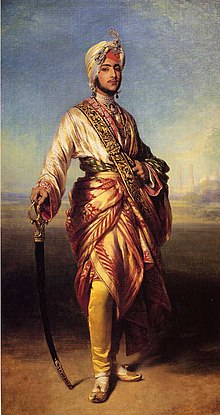Sikh diaspora
This article has multiple issues. Please help improve it or discuss these issues on the talk page. (Learn how and when to remove these template messages)
|

| Part of a series on |
| Sikhism |
|---|
 |
The Sikh diaspora is the modern
The diaspora is commonly accepted to have begun after the fall of the Sikh Empire in 1849 and the empire's subsequent annexation into British India. The onset of the Sikh diaspora is represented by Duleep Singh, the last emperor of the Sikhs, who was forced into exile by the British. Starting with this event, the rate of Sikh migration from Punjab has remained high and included a number of international destinations.
Religion
With more than 25 million worldwide,
Historical migration patterns
The Sikhs as a political entity, distinct from other Indian traditions, can be said to have begun with the martyrdom of the fifth Sikh Guru,
Annexation of the Punjab

Sikh migration from Punjab began in earnest in the second half of the 19th century, when the
Although a largely secular figure who did little for the Sikh body politic, Axel (2001)[9] argues that Singh's exile has had a major impact on the Sikh diaspora psyche. Axel[10] says that Singh is the archetypal "tragic hero" figure in Sikh culture, "a King without a Kingdom, a Sikh separated from his people".
Having annexed the
20th century
Sikhs made tremendous contributions to Punjab from 1857 to 1947, including founding the city of
The era of peace and prosperity ended in 1947, with the partition of Punjab between India and Pakistan. Sikh communities were practically wiped out from Lahore, Rawalpindi, Multan, Sialkot, Lyallpur, Jhelum, Gujrat, Sargodha, Sheikhupura, and other districts of West Punjab. The birthplace of Sikhism, Nankana Sahib, was split away in West Punjab. Millions of Sikhs fled to freedom and safety in East Punjab; smaller numbers also fled to Afghanistan.[12]
In the 1960s and beyond, many Sikhs migrated to the
Khalistan movement

Axel (2001)
In 1971, Jagit Singh Chohan, an ex-minister in a short-lived government of

Tatla summarises the change in Sikh diaspora community leaders post-1984 a being a "painful transition from a self-confident community with haughty discourse, to the self-defensive strategies of a vulnerable minority".
Axel (2001)[9] argues that the history of the Sikh diaspora, its psyche of grievance, and the violence inflicted on it, means that the notion of the Sikh diaspora as a community today inevitably converges on the notion of Khalistan. In addition to this, Axel points out the "nightmare" scenario facing the Sikh diaspora: the Indian state "demands" the "Unity-in-Diversity" model of rashtriya ekta (national integration), which Axel contends is signified by "the denial of difference through surrender, assimilation and integration".
Sikh identity today
Whilst the rate of Sikh migration from Indian Punjab has remained high, traditional patterns of Sikh migration that favored English-speaking countries, particularly the United Kingdom, have changed in the past decade due to factors such as stricter immigration procedures. Moliner (2006)[24] states that as a consequence of the "fact" that Sikh migration to the UK had "become virtually impossible since the late 1970s", Sikh migration patterns altered to continental Europe. Italy has now emerged as a fast-growing area for Sikh migration,[25] with Reggio Emilia and the province of Vicenza being areas of significant Sikh population clusters.[26] Italian Sikhs are generally involved in the areas of agriculture, agro-processing, machine tools, and horticulture.[27] Canada has maintained a liberal immigration policy, and the Sikh community there is the largest in proportion to the country's population, even above India (2.1% of Canada's population versus 1.7% of India's). The largest North American Sikh community is thought to be located in south Vancouver, British Columbia, and nearby Surrey.[citation needed]
In the post-9/11 era, the Sikh diaspora in Europe and North America stood out as a visible minority often confused with radical Islamic groups because of their turbans. This has included numerous hate crimes targeting Sikhs.[citation needed] France banned turban-wearing Sikh students from publicly funded schools as part of a broader policy originally intended to restrict Muslim headscarves.[citation needed] Western security think tanks have quoted the Air India bombing to justify profiling of Sikh travellers at airports.[citation needed] Countering this train of thought, on 1 October 2017, Canadian politician Jagmeet Singh, a Sikh, was elected leader of the federal New Democratic Party,[28] and on 16 January 2018, Gurbir Grewal became attorney general of New Jersey—the first practicing Sikh in the US to become a state attorney general.[29]
See also
References
- ^ Johnson and Barrett (2004) used in map construction. Research Paper: Quantifying alternate futures of religion and religions by Todd M. Johnson and David B. Barrett (2004). Refer to Table 1. Global adherents of the world’s 18 major distinct religions, AD 1900–2025. Published by Elsevier Ltd, Available online 15 July 2004 [1]
- ^ Encarta "Sikhism – MSN Encarta". Archived from the original on 2 October 2009. Retrieved 25 June 2009.
- ^ "Sikhism". Encyclopædia Britannica. Retrieved 7 August 2018.
- ^ CIA Factbook
- ^ a b c "Sikh Religion Census 2011". census2011. Retrieved 21 January 2018.
- ^ "NHS Profile, British Columbia, 2011". Statistics Canada. 8 May 2013. Retrieved 8 September 2019.
- ^ BBC History of Sikhiam - The Khalsa
- ISBN 0-19-566111-7
- ^ a b c A review of The Nation's Tortured Body: Violence, Representation, and the Formation of the Sikh "Diaspora" by Brian Keith Axel . Pub. by Duke University Press (2001).
- ^ A review of The Nation's Tortured Body: Violence, Representation, and the Formation of the Sikh "Diaspora" by Brian Keith Axel . Pub. by Duke University Press (2001). pp. 48–65
- ^ Diffusion of Sikhism and recent migration patterns of Sikhs in India by A. K. Dutt1 and S. Devgun. Pub. GeoJournal Volume 1, Number 5 / September,1977.Pp 81-89. Available online [2][dead link]
- ^ "Explainer: who are the Afghan Sikhs?". The Conversation. 20 August 2014.
- ^ Sikhism. Encyclopædia Britannica. 2007. Encyclopædia Britannica Online. 12 September 2007 [3]
- ^ The Sikh Diaspora Search for Statehood by Darshan Singh Tatla (1998). pp. 16–33. Pub. by University of Washington Press. 10-295-97715-9
- ISBN 0-8020-8631-4
- ^ A review of The Nation's Tortured Body: Violence, Representation, and the Formation of the Sikh "Diaspora" by Brian Keith Axel . pp. 68–72. Pub. by Duke University Press (2001).
- ^ BBC Archives: After Blue Star
- ^ a b
Shackle, Christopher; Gurharpal Singh; Arvind-Pal Mandair (2001). Sikh Religion, Culture and Ethnicity. Richmond, Surrey: Curzon Press. pp. 142–161. ISBN 0-7007-1389-1.
- ^ Haider, Masood (8 June 2014). "Sikhs living abroad to hold 'referendum' for separate homeland". DAWN.COM. Retrieved 26 April 2019.
- ^ Singh, Yoshita (20 March 2014). "US judge reserves ruling on 1984 anti-Sikh riots". Mint. Retrieved 26 April 2019.
- ISSN 0971-751X. Retrieved 26 April 2019.
- ^ "Over 20,000 People Sign White House Petition for Jagtar Hawara's Release". NDTV.com. Retrieved 26 April 2019.
- ^ "UK takes cautious line on pro-Khalistan SFJ meet". The Tribune India. 11 July 2018.
- ^ Sikh Migration Patterns – 'Workshop on Indian Migration' at Laboratoire d'Anthropologie Urbaine/CNRS (14/15 November 2006) Abstract 'Sikhs in France' by Christine MOLINER (PhD Student, Ecole des Hautes Etudes en Sciences Sociales (EHESS))"Archived copy". Archived from the original on 17 November 2006. Retrieved 4 April 2008.
{{cite web}}: CS1 maint: archived copy as title (link) - ^ Sikh Storia e immigrazione – The Sikhs: History and Immigration by R. Cipriani (2006). Pub. in International Sociology.2006; 21: 474-476 Available on "I Sikh Storia e immigrazione [The Sikhs: History and Immigration] -- Cipriani 21 (3): 474 -- International Sociology". Archived from the original on 29 May 2006. Retrieved 4 April 2008.
- ^ Now, Sikhs do a Canada in Italy
- ^ Report of 'NRI' News in ITALY
- ^ "Jagmeet Singh makes history with NDP leadership victory on first ballot". theglobeandmail.com. 1 October 2017. Retrieved 18 June 2023.
- ^ N.J. gets first Sikh attorney general in U.S. history
Further reading
- "Twice Versus Direct Migrants: East African Sikh Settlers in Britain" by Parminder Bhachu. Pub. by Clark University (7 April 1990).
- "The Sikh Diaspora Search for Statehood" by Darshan Singh Tatla (1998) University of Washington Press. ISBN 0-295-97715-9
- "Contesting Khalistan, the Sikh diaspora, and the politics of separatism" /Gunawardena, Therese Suhashini. Jan 2001 Thesis (PhD). Pub. by University of Texas at Austin, 2001. Available at: http://repositories.lib.utexas.edu/handle/2152/6181
- "Relational Embodiments of a Sikh Diaspora" by Anjali Gera Roy Pub. by Indian Institute of Technology, Kharagpur, India (2001). Available at https://web.archive.org/web/20070701185828/http://social.chass.ncsu.edu/jouvert/v7is1/gera.htm.
- "Sikhs at Large: Religion, Culture, and Politics in Global Perspective" by Verne A. Dusenbery (2008) Oxford University Press. ISBN 0-19-568598-9
- "Sikh Diaspora Philanthropy in Punjab: Global Giving for Local Good" by Verne A. Dusenbery and Darshan S. Tatla, eds. (2009) Oxford University Press. ISBN 0-19-806102-1
- "Sikhs in Latin America: Travels Among the Sikh Diaspora" by Swarn Singh Kahlon (2012) Manohar Publishers and Distributors, New Delhi, India. ISBN 978-81-7304-938-5
External links
- The Indian Diaspora, official Government of India website (archived)
- Sikh NRI Online, information pertaining to Sikh non-resident Indians worldwide (archived)
- History of Sikh diaspora in Canada and USA
- Sikh Global Village – Latin America
